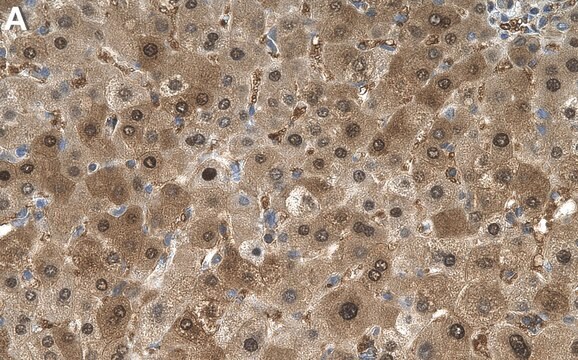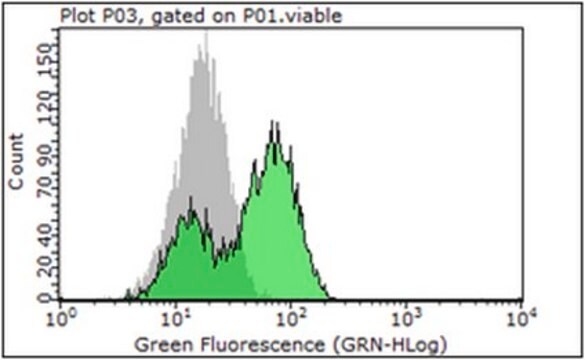推薦產品
生物源
mouse
品質等級
抗體表格
ascites fluid
抗體產品種類
primary antibodies
無性繁殖
6F5, monoclonal
物種活性
mouse, human
技術
flow cytometry: suitable
immunocytochemistry: suitable
western blot: suitable
同型
IgG1
UniProt登錄號
運輸包裝
wet ice
目標翻譯後修改
unmodified
基因資訊
human ... SOD1(6647)
一般說明
Superoxide dismutase 1 (SOD1) also known as Superoxide dismutase [Cu-Zn] to distinguish it from SOD2 which uses manganese as its cofactor, is the cytosolic form of the enzyme that catalyzes the breakdown of superoxide into oxygen and hydrogen peroxide and is our primary anti-oxidant combating enzyme. SOD1 performs its function with the help of co-factors and one protein in particular is vital to its proper functioning. Copper chaperone protein (CCS) is a metalloprotein that specifically delivers Cu to SOD1 and may activate SOD1 through direct insertion of the Cu cofactor. Interestingly, defects in SOD1 are the cause of a form of ALS (Amyotrophic Lateral Sclerosis or Lou Gehrig′s disease) and much research is centered on understanding how over-active or under-active SOD1 contributes to the disease. EMD-Millipore′s Anti-SOD1 mouse monoclonal antibody has been tested in western blot on HeLa, NIH3T3, A549 and A431 cell lysates and fluorescent immunocytochemistry on PANC1, SKBR-3 and 3T3-L1 cells in culture. The antibody has also been tested in flow cytometry on A431 cells in culture.
免疫原
Purified recombinant fragment of human SOD1 expressed in E. Coli.
應用
Anti-SOD1 Antibody, clone 6F5 is a highly specific mouse monoclonal antibody, that targets Superoxide Dismutase & has been tested in western blotting, ICC & Flow Cytometry.
Immunocytochemistry Analysis: A 1:200-1,000 dilution from a representative lot detected SOD1 in PANC-1, SKBR-3, and 3T3-L1 cells.
Flow Cytometry Analysis: A 1:200-400 dilution from a representative lot detected SOD1 in non serum starved A431 cells.
Optimal working dilutions must be determined by end user.
Flow Cytometry Analysis: A 1:200-400 dilution from a representative lot detected SOD1 in non serum starved A431 cells.
Optimal working dilutions must be determined by end user.
Research Category
Apoptosis & Cancer
Apoptosis & Cancer
Research Sub Category
Apoptosis - Additional
Apoptosis - Additional
品質
Evaluated by Western Blotting in HeLa, NIH/3T3, A549, and A431 cell lysates.
Western Blotting Analysis: A 1:500-2,000 dilution of this antibody detected SOD1 in HeLa, NIH/3T3, A549, and A431 cell lysates.
Western Blotting Analysis: A 1:500-2,000 dilution of this antibody detected SOD1 in HeLa, NIH/3T3, A549, and A431 cell lysates.
標靶描述
~18 kDa observed. Uncharacterized bands may appear in some lysate(s).
外觀
Unpurified
Mouse monoclonal IgG1 ascitic fluid containing up to 0.1% sodium azide.
儲存和穩定性
Stable for 1 year at -20°C from date of receipt.
Handling Recommendations: Upon receipt and prior to removing the cap, centrifuge the vial and gently mix the solution. Aliquot into microcentrifuge tubes and store at -20°C. Avoid repeated freeze/thaw cycles, which may damage IgG and affect product performance.
Handling Recommendations: Upon receipt and prior to removing the cap, centrifuge the vial and gently mix the solution. Aliquot into microcentrifuge tubes and store at -20°C. Avoid repeated freeze/thaw cycles, which may damage IgG and affect product performance.
分析報告
Control
HeLa, NIH/3T3, A549, and A431 cell lysates
HeLa, NIH/3T3, A549, and A431 cell lysates
免責聲明
Unless otherwise stated in our catalog or other company documentation accompanying the product(s), our products are intended for research use only and are not to be used for any other purpose, which includes but is not limited to, unauthorized commercial uses, in vitro diagnostic uses, ex vivo or in vivo therapeutic uses or any type of consumption or application to humans or animals.
未找到適合的產品?
試用我們的產品選擇工具.
儲存類別代碼
12 - Non Combustible Liquids
水污染物質分類(WGK)
nwg
閃點(°F)
Not applicable
閃點(°C)
Not applicable
分析證明 (COA)
輸入產品批次/批號來搜索 分析證明 (COA)。在產品’s標籤上找到批次和批號,寫有 ‘Lot’或‘Batch’.。
Xiao-Dan Hao et al.
Scientific reports, 7(1), 13570-13570 (2017-10-21)
Keratoconus (KC) is a common degenerative corneal disease, and heredity plays a key role in its development. Although few genes are known to cause KC, a large proportion of disease-causing genes remain to be revealed. Here, we report the identification
我們的科學家團隊在所有研究領域都有豐富的經驗,包括生命科學、材料科學、化學合成、色譜、分析等.
聯絡技術服務







